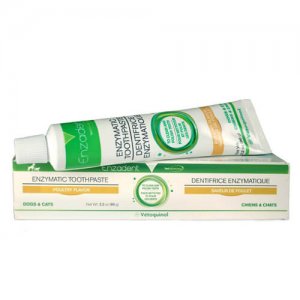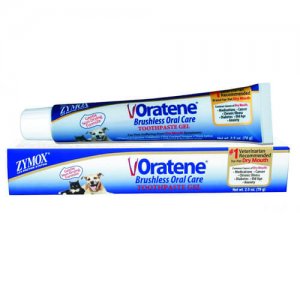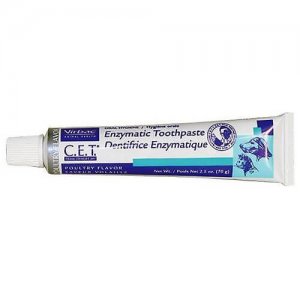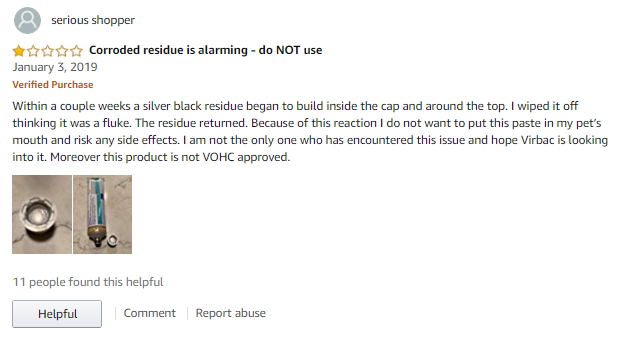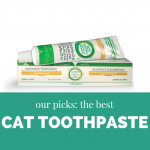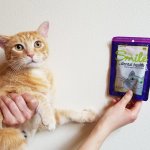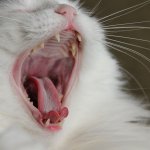Best Cat Toothpaste of 2019: Top 5 Products That Actually Work
Last Updated on
The best cat toothpaste contains antibacterial ingredients, tastes delicious, and has passed clinical tests that prove it works. That’s why we chose Petsmile as the best cat toothpaste on the market. It’s the only pet toothpaste accepted by the Veterinary Oral Health Council. Clinical testing showed that Petsmile reduces plaque, improves gum health, stops bad breath, and improves oral health.
Read on for our other picks for the best cat toothpaste, an ingredient glossary, and an explanation of how cat toothpaste should work.
Note: This is an updated version of our 2018 buyer’s guide. We’ve learned a lot about cat dental care in the last year, discovered some new products, and wanted to make a new, better, and easier-to-read guide. If you find this guide helpful, please go ahead and give it a share—it helps us more than you could know!
Best Cat Toothpaste: Wildernesscat’s Top 5 Recommendations
Some of the product links are affiliate links and Wildernesscat will receive a percentage of the sale. It doesn’t cost any extra but helps us to continue sharing the radical cat parenting message. Thank you for your support!
 Petsmile Professional Pet Toothpaste Review
Petsmile Professional Pet Toothpaste Review
Ingredients: Calprox, Deionized Water, Glycerin, Citric Acid, Dicalcium Phosphate Dihydrate, Cellulose Gum, Urea Peroxide, Carbopol 934P, Potassium Hydroxide, Flavor, Sodium Benzoate, Phosphoric Acid, Cetylpyridinium Chloride.
Petsmile cat toothpaste has several qualities that set it apart as the number one best cat toothpaste on the market. It’s the only pet toothpaste to have attained the approval of the Veterinary Oral Health Council (VOCH), an organization that reviews pet dental health products. In order to attain the organization’s seal of acceptance for a plaque removal claim, a product must reduce 10% of plaque after seven days.
The main ingredient in Petsmile toothpaste is a proprietary ingredient called Calprox®. It’s an encapsulated form of calcium peroxide and minerals that, according to the company, gently and effectively dissolve the bio-film on the surface of your cat’s teeth. By removing this sticky film, Calprox keeps plaque, bacteria, and stains from sticking to the teeth. Calprox® also helps to remineralize enamel to keep your cat’s teeth strong. When compared to a competitor’s product, Calprox removed 62% more plaque.
The company has used Calprox® in its Supersmile products for decades. Supersmile is a whitening toothpaste for people and claims to be the number one top toothpaste recommended by cosmetic dentists. It was developed by Dr. Irwin Smigel, a dentist known as the “Father of Aesthetic Dentistry”.
The pet toothpaste has a London Broil flavor that, according to customer reviews, cats seem to love. The company says that the toothpaste is powerful enough to use without a toothbrush, but we prefer to combine a good toothpaste with the abrasive action of a toothbrush.
Overall, this appears to be an outstanding toothpaste and a trustworthy choice.
Take 20% off your order at PetsmileUSA.com when you use code HAPPYPET20 at checkout!
 Pet Essentials Healthymouth Tooth Gel Review
Pet Essentials Healthymouth Tooth Gel Review
Ingredients: Sodium Bicarbonate, Sorbitol, Organic Glycerin, Water, Potassium Sorbate, Tetrasodium, Pyrophosphate, Organic Pomegranate, Natural Xanthan Gum, Organic Yucca Extract, Zinc Gluconate, Organic Blueberry, Organic Papain (Papaya Extract), Riboflavin (Vitamin B2), Ascorbic Acid (Vitamin C), Salmon Oil (source of Omega-3), Natural Fish Flavor, Organic Clove Extract, Organic Cinnamon Extract, Natural Taurine, Chlorophyll, Sorbic Acid (natural preservative derived from mountain berries).
Healthymouth dental gel went through a clinical trial and was shown to reduce plaque in the cats tested. It was accepted by the VOHC as an effective solution for plaque removal in 2011.
Healthymouth dental gel is an enzymatic, antibacterial gel and doesn’t include any synthetic or artificial ingredients. Healthymouth, known for their dental water additives, started producing this dental gel as an answer to cat guardians who complained that their cats didn’t drink enough water to get the benefits of the water additive.
Healthymouth gel has two active ingredients that help to slow down the production of plaque and bacteria. Papain, a protein-digesting enzyme sourced from papaya and zinc gluconate, an antimicrobial, combine to reduce bacterial growth in your cat’s mouth. These combine with the other ingredients to fight bacteria long-term. The dental gel also softens plaque over time, making it easier to remove with a toothbrush.
The Healthymouth cat gel contains salmon oil, making it more palatable for cats.
Healthymouth cat dental gel is an expensive choice at $68.22 for a 2 oz. jar, but its history of effectivity and VOHC-approved status make it stand out.
Enzadent Pet Toothpaste Review 
Ingredients: Sorbitol, Glycerin, Silica, Calcium Pyrophosphate, Calcium Carbonate, Poultry Extract, Purified Water, Cellulose Gum, Sodium Benzoate, Calcium Lactate, Potassium Thiocyanate, Zinc Gluconate, Vitamin E, Glucose Oxidase, Lactoperoxidase, Lactoferrin, Lysozyme.
This toothpaste has four different enzymatic cleaners—glucose oxidase, lactoperoxidase, lactoferrin, and lysozyme, which work synergistically to destroy multiple types of bacteria in your cat’s mouth. It has a cat-friendly poultry flavor and, according to customer reviews, seems to work well.
We’ve used this toothpaste on Wessie and Forest’s teeth for months and, while they’re still not huge fans of the toothbrush, they seem to enjoy the taste.
This toothpaste is made in the USA. Overall, Enzadent appears to be an economical, effective alternative to ever-popular Virbac C.E.T. cat toothpaste, which we’ll review later.
ZYMOX Oratene Oral Care Therapy Dental Gel 
Ingredients: Glyceryl Methacrylate, Polyglycitol, Sorbitol, Cellulose Gum, Dextrose, Mutanase, Lactoperoxidase, Lysozyme, Lactoferrin, Glucose Oxidase, Potassium Thiocyanate, Aloe Vera, Dextranase
This is the most enzyme-packed cat toothpaste on this list. It has the power of seven different enzymes, starting with glucose oxidase, lactoperoxidase, lysozyme, and lactoferrin. These are familiar names common in other toothpaste products. Zymox, however, steps outside the box with a combination of mutanase and dextranase. These enzymes increase the solubility of plaque, helping to prevent it from bonding to the surfaces of your cat’s teeth. Oratene also contains glucose oxidase.
While the enzymatic intensity of this toothpaste is great, we bump it down the list because it doesn’t have a tasty cat-friendly flavor. Instead of tasting like meat, the gel has a “mildly sweet, non-bitter flavor”. It might not be the best choice for brushing-resistant cats.
Virbac C.E.T. Enzymatic Poultry Cat Toothpaste Review 
Ingredients: Glucose Oxidase, Lactoperoxidase, Sorbitol, Purified Water, Dicalcium Phosphate Anhydrous, Hydrated Silica, Glycerine, Poultry Digest, Dextrose, Xanthan Gum, Titanium Dioxide, Sodium Benzoate, Potassium Thiocyanate.
Frankly, we wouldn’t list this product if it wasn’t so popular and if so many people didn’t swear by it. As we’ll mention later, this toothpaste has some problems and it’s not clear that they’ve been resolved. Virbac’s popular toothpaste comes in a wide range of flavors, including vanilla mint, seafood, poultry, and beef. Wessie goes nuts over the poultry flavor, so we’ve chosen it as our top pick.
The toothpaste contains two types of enzymes—glucose oxidase and lactoperoxidase. These enzymes appear at the beginning of the ingredient list, suggesting a generous dose of cleaning power. It also contains abrasive agents to help scrub off plaque.
This ultra-popular toothpaste has a packaging problem. Multiple reviewers say that their tube was corroded and contaminated the product. One Chewy reviewer said that their tube had a new plastic rim, though it’s unclear whether or not this change has resolved the corrosion problem.
Be cautious when you open the tube and look closely for signs of contamination. This is a well-respected product that receives hundreds of positive reviews, but the corrosion problem is something to seriously consider before using Virbac C.E.T toothpaste.
How We Chose the Best Cat Toothpaste on the Market
In general, we looked for enzymatic toothpaste.
In most cases, unless, your cat’s toothpaste contains antibacterial enzymes, you may as well brush with a toothbrush and water or tuna juice.
Enzymatic toothpaste builds upon the enzymatic action already present in your cat’s mouth. Some of the enzymes used in toothpaste are naturally found in saliva. Others are found in plants and others are produced by insects. Most cat toothpaste contains a combination of enzymes that work synergistically to destroy oral bacteria.
According to our research, Petsmile is the only toothpaste that performs well without the help of antibacterial enzymes.
We looked for toothpaste that had passed legitimate tests of effectiveness…very few had.
While searching for the best cat toothpaste, it became apparent that most of the products available are marketed on pretty flimsy premises—they should work because they contain antibacterial enzymes or other ingredients, but it’s unclear whether or not they do work when used on a real cat.
In an article called “10 veterinary dental products you can recommend with a smile”, Dr. Jan Bellows tells vets that if a product has the VOHC seal of approval, they can feel confident recommending it. The VOHC or Veterinary Oral Health Council has accepted 15 products for cats and about twice as many for dogs.
We preferred cat toothpaste with an appetizing flavor.
Since one of cat toothpaste’s main jobs is making the brushing experience more fun, it has to taste good. We looked for pastes with cat-friendly meat flavor and a history of making cats purr—or at least lick the toothbrush.
Cat Toothpaste Enzyme Glossary
- Glucose Oxidase is naturally produced by some species of fungi and insects, who use it to produce hydrogen peroxide. Your cat’s body is already capable of producing hydrogen peroxide. Glucose oxidase stimulates that production. Just as hydrogen peroxide from the pharmacy makes a simple mouthwash, the body’s natural hydrogen peroxide destroys oral bacteria.
- Lactoperoxidase is naturally present in your cat’s saliva. It increases the body’s hydrogen peroxide production and turns thiocyanate to hypothiocyanite, an organic compound that helps to reduce oral bacteria.
- Lysozyme has been dubbed “the most important salivary component with antibacterial properties”. You’ll find it throughout the natural world wherever antibacterial protection is needed—lysozyme is present in saliva, albumen, tears, and mucus. It works by breaking the chemical bonds of bacterial cell walls.
- Lactoferrin is also naturally present in your cat’s saliva. Lactoferrin makes bacteria’s cell walls weaker, helping lysozyme to do its job.
Cat Toothpaste Ingredient Glossary
- Ethanol is added as an antibacterial agent. If your cat consumes too much of it, it could depress the central nervous system (make him drunk), which could have serious negative health effects. However, in the small doses found in cat toothpaste, ethanol should be completely safe for your cat.
- Sorbitol might be the most controversial ingredient used in cat toothpaste. It’s present in the most popular formulas, which are made for both dogs and cats. Though sorbitol is a sweetener, its primary role in toothpaste is as a humectant. It helps the toothpaste to retain moisture and prevents it from drying out over time. In the small quantities found in cat toothpaste, sorbitol is probably not dangerous. In large amounts, it’s a laxative and could give your cat an upset stomach. It’s safe for cats with diabetes.
- Dicalcium Phosphate Anhydrous is often found in toothpaste as a polishing agent – it helps to abrade plaque and keep your cat’s teeth fresh.
- Hydrated Silica is a form of silicon dioxide used in toothpaste as a mild abrasive. It’s entirely safe for cats to eat.
- Glycerine is derived from both plant and animal sources like tallow, soybean, and palm. It is a viscous sugar substitute that sweetens the toothpaste and gives it a smooth texture.
- Poultry Digest is a concentrated flavor that’s usually made from hydrolyzed animal tissue. While poultry flavor is a particularly common one, other cat toothpastes contain variations on the theme, like animal digest, natural flavor, and other flavor additives.
- Dextrose is a simple sugar chemically identical to glucose. Cat toothpaste containing this ingredient may not be safe for cats with diabetes—check with your veterinarian before giving it to your cat.
- Xanthan Gum is a thickener made from fermented corn sugar. Xanthan gum is very common in cat food and other products. In large quantities, it could cause diarrhea, but in the amount found in toothpaste, it should be perfectly safe.
- Titanium Dioxide is a mineral-based whitening agent. The little flakes of this stuff are used in paint and they’re used to whiten teeth when included in toothpaste. There’s really nothing dangerous about this ingredient.
- Sodium Benzoate is a preservative found naturally in some fruits, vegetables, and dairy products. Sodium benzoate is synthetically produced by reacting sodium hydroxide with benzoic acid. While this additive is generally considered safe for humans, it may be risky for cats in concentrations over 1%.
- Potassium Thiocyanate – I haven’t found much information on this ingredient. It’s a potassium salt that’s used as a stabilizer. If you can provide more information about the effects of potassium thiocyanate for cats, please contact us. UPDATE: We found an interesting forum post in which someone said that potassium thiocyanate is “A chemical used for fake blood in movies. Just a salt, not known to be unsafe. FDA says go.”
Once you’ve found the best cat toothpaste, it’s time to start brushing.
If your cat is middle-aged or a senior and you’ve never brushed his teeth before, you may want to take him in for a dental exam before you start brushing. Most older cats have some form of dental disease, and if this disease has led to sensitivity, brushing could be a painful experience.
Find out about any loose or painful teeth before you make your cat associate the toothbrush with pain.
If your cat is younger and doesn’t appear to have any dental problems, it’s better to start immediately and get your cat’s teeth checked out later.
Click here to watch a great video on how to brush your cat’s teeth.
While brushing your cat’s teeth is the best way to prevent dental disease and slow its progression, the best cat toothpaste and a fine toothbrush can do nothing to fix years of neglect.
Professional dental care is the only way to remove calculus (hardened plaque), so it’s a good idea to schedule a professional cleaning once a year. The vet will put your cat under full anesthesia and then perform a full dental inspection and cleaning with scrapers, probes, and mirrors, just like a human dental exam. These dental cleanings are completely safe for most cats.
Once your cat is a senior or has health problems, it may no longer be a good idea to put him under anesthesia, so talk to your vet about whether or not professional cleaning is a good idea.
Try to brush your cat’s teeth once a day.
If teeth brushing is a new addition to your cat’s routine, start off slow. It’s important that you let your cat adjust slowly to the new sensation of having a brush rubbed around in their mouth—don’t force it or you’ll be fighting your cat every time it’s toothbrush time.
If possible, brush your cat’s teeth once a day. Try to brush around the same time each day, preferably at a time when your cat is relaxed and happy. You can make it a part of daily grooming or as a follow up to playtime. Cats love routine and structuring a tooth brushing routine will make it easier for you to remember, too.
If brushing is a struggle and you can’t bring yourself to brush daily, remember, brushing once a week is better than never. I like this post by cat-schlepper Solana Joy about her struggle to maintain a cat tooth-brushing routine and how she’s trained herself to think of Tuesday as Toothsday. Like I said—once a week is better than never!
For more information on how to get started brushing your cat’s teeth, visit our complete guide:
Let’s End Cat Dental Disease – How to Brush Your Cat’s Teeth

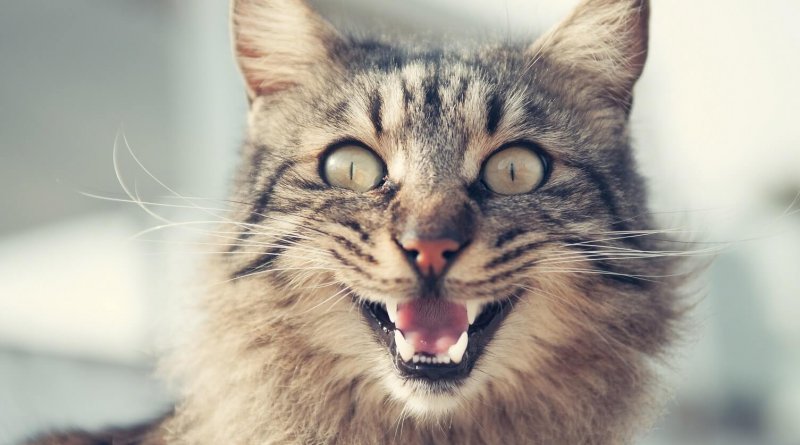
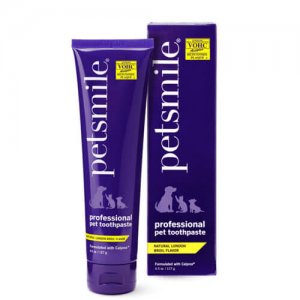
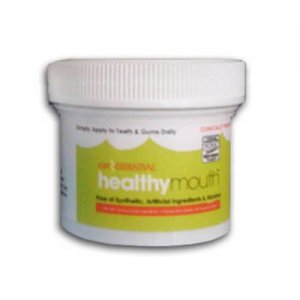 Pet Essentials Healthymouth Tooth Gel Review
Pet Essentials Healthymouth Tooth Gel Review